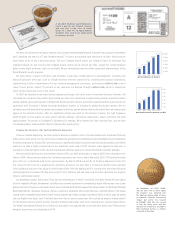Southwest Airlines 2007 Annual Report Download - page 20
Download and view the complete annual report
Please find page 20 of the 2007 Southwest Airlines annual report below. You can navigate through the pages in the report by either clicking on the pages listed below, or by using the keyword search tool below to find specific information within the annual report.
PART I
Item 1. Business
Overview
Southwest Airlines Co. is a major passenger airline
that provides scheduled air transportation in the
United States. Based on the most recent data available
from the U.S. Department of Transportation (“DOT”),
Southwest is the largest air carrier in the United States, as
measured by the number of originating passengers boarded
and the number of scheduled domestic departures. South-
west commenced Customer Service on June 18, 1971, with
three Boeing 737 aircraft serving three Texas cities —
Dallas, Houston, and San Antonio. As of December 31,
2007, Southwest operated 520 Boeing 737 aircraft and
provided service to 64 cities in 32 states throughout the
United States. In 2007, Southwest recommenced service to
San Francisco International Airport.
Southwest focuses principally on point-to-point,
rather than hub-and-spoke, service, providing its markets
with frequent, conveniently timed flights and low fares.
As of December 31, 2007, Southwest served 411 nonstop
city pairs. Historically, Southwest has served predomi-
nantly short-haul routes, with high frequencies. In recent
years, Southwest has complemented this service with
more medium to long-haul routes, including transconti-
nental service.
Southwest has a low cost structure, enabling it to
charge low fares. Adjusted for stage length, Southwest has
lower unit costs, on average, than most major network
carriers. Southwest’s low cost advantage is facilitated by
reliance upon a single aircraft type, an operationally
efficient route structure, and highly productive
Employees.
Fuel Cost Impact and Related Growth Plans and
Initiatives
Fuel prices can have a significant impact on South-
west’s profitability. From October 1, 2007 through
December 31, 2007, the average cost per gallon for jet
fuel was $1.87. Southwest’s average cost of jet fuel, net of
hedging gains and excluding fuel taxes, over the past five
years was as follows:
Year
Cost
(Millions)
Average Cost
Per Gallon
Percent of
Operating Expenses
2003 . . $ 830 $ .72 14.9%
2004 . . $1,000 $ .83 16.3%
2005 . . $1,341 $1.03 19.6%
2006 . . $2,138 $1.53 26.2%
2007 . . $2,536 $1.70 28.0%
Fuel costs, coupled with evidence of slowing eco-
nomic growth and the impact of labor costs, led to the
Company’s decision in 2007 to slow capacity growth
through a combination of schedule adjustments and fleet
changes. The Company has been working on optimizing
its flight schedule by reducing frequency on less profitable
routes and reallocating capacity to potentially more
rewarding markets. This in turn has allowed the Com-
pany to reduce the number of aircraft it will add to its fleet
in 2008. As discussed further below under “Properties,”
the Company has also adjusted its aircraft deliveries from
Boeing.
In addition to schedule adjustments, the Company
has developed several initiatives designed to enhance
Customer Service and to help offset increasing costs
through improving future revenues. These initiatives
include, among others:
• Implementation of a new Customer boarding
method for flights;
• Commencement of a significant gate re-design to
enhance the airport experience for Customers;
• Introduction of a new fare structure, including a
“Business Select” product;
• Introduction of enhancements to the Company’s
Rapid Rewards frequent flyer program;
• Launch of a new advertising campaign;
• Announcement of an expansion of the Company’s
GDS (Global Distribution System) and corporate
travel account efforts; and
• Exploration of international codeshare alliances.
The Company’s initiatives are discussed in more
detail below under “Operating Strategies and Market-
ing.” Fuel costs and Southwest’s fuel hedging activities
are discussed in more detail below under “Risk Factors”
and “Management’s Discussion and Analysis of Financial
Condition and Results of Operations.”
Regulation
The airline industry is regulated heavily, especially
by the federal government. Examples of such regulation
include:
Economic and Operational Regulation
•Aviation Taxes. The statutory authority for the
federal government to collect aviation taxes, which
are used, in part, to finance the nation’s airport and
air traffic control systems, and the authority of the
1
























